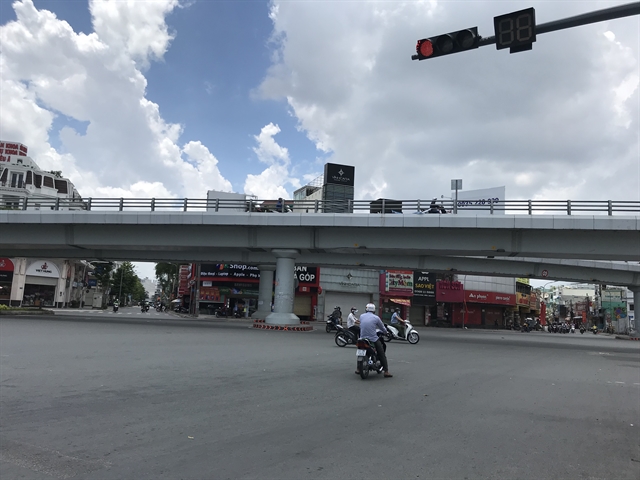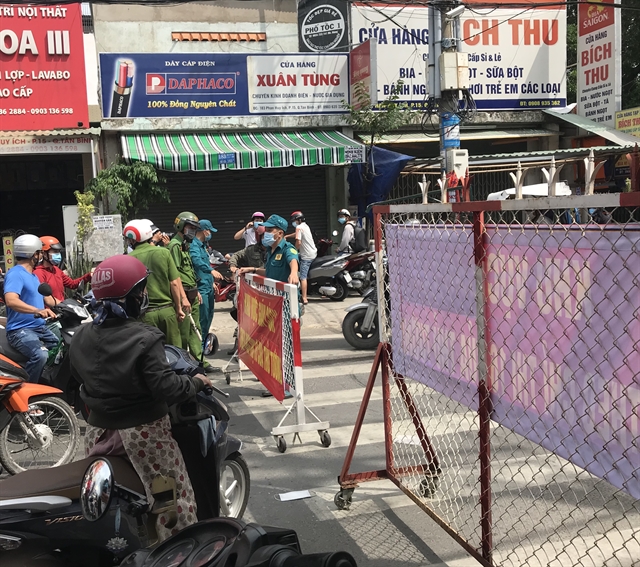 Society
Society

Healthcare staff have been working day and night to provide screening tests in high-risk areas in HCM City to detect cases in the community amid the latest COVID-19 outbreak.

|
| Staff from HCM City Traditional Medicine Institute take samples from residents in Gò Vấp District. — Photo courtesy of the institute |
Gia Lộc
HCM CITY— Healthcare staff have been working day and night to provide screening tests in high-risk areas in HCM City to detect cases in the community amid the latest COVID-19 outbreak.
Local authorities and healthcare staff are tracing and taking samples immediately after being informed of any new case. The city’s hospitals, health centres, and universities of medicine have set up more than 600 teams that are taking samples. The teams can take up to 100,000 samples in 24 hours during emergency situations.
The city Department of Health, for example, asked the Ear-Nose-Throat Hospital of HCM City to immediately send teams to the Moscow apartment building in District 12’s Tân Thới Nhất Ward where cases related to the Gò Vấp cluster were believed to exist.
The team then went to Trương Định Primary School in the ward to take samples from 2,000 residents in neighbouring areas with co-operation from the Traditional Medicine Hospital.
As of June 1, 12 people in the ward had tested positive for coronavirus, the highest number of cases in District 12. The area is home to thousands of workers and hundreds of enterprises.
The HCM City Traditional Medicine Institute has set up five taskforce teams to take samples. On May 28, the institute’s teams began working in Gò Vấp District’s Ward 15, taking nearly 1,900 samples. They also took another 2,490 samples from residents in the districts’ other wards on May 30.
Dr Đỗ Thường Quân, head of the general planning department at the institute, said: “Because of the variants’ rapid spread and the high danger level in the Gò Vấp cluster, it is necessary to trace and detect patients, their close contacts, and the contacts of the latter. Taking samples on a large scale is vital for screening and stamping out the transmission there.”
Dr Lê Ngọc Tuấn Anh, of the institute's taskforce team, said: “We have tried our best to complete the hard work, hoping to ensure safety for the whole city.”
Besides the high-risk residential areas in districts Gò Vấp, Tân Phú and others, more than 280,000 workers and 3,000 experts at companies in Saigon Hi-tech Park, industrial parks and export processing zones have provided samples for tests.
On June 1, more than 300 health workers and Phạm Ngọc Thạch University of Medicine visited Saigon Hi-tech Park to take more than 25,000 samples after they had worked for nine hours on that day. Nearly 10,000 workers are expected to provide samples on June 3-4.
The city Centre for Disease Control and Prevention said that testing was essential to control the spread. With 23 health facilities meeting standards for COVID-19 tests in the city, the total testing capacity has reached 15,000 samples per 24 hours, and in some cases, 35,000-40,000 per 24 hours.

|
| A 15-day social distancing under Directive No.16 has limited traffic in Gò Vấp District. — VNS Photo Gia Lộc |
Social distancing
Besides COVID-19 screening on a large scale, the city started a 15-day social distancing period on May 31 under Government Directive No.15.
Non-essential services have been shut as well as entertainment, cultural and sports activities in public. Gatherings of more than five people in public are banned (Directive 15 allows gatherings of up to 10 people in public, but HCM City's authorities went a step further), and events and meetings with more than 20 people in one room are not permitted.
People must keep a 2-metre distance from others in public, and transportation from COVID-19 hit areas must be limited.
Streets such as Trường Chinh and Cộng Hòa that are usually congested have been free of heavy traffic.
Nguyễn Việt Hưng, a resident in District 12, said: “HCM City carried out social distancing last year, so I have experience this time. Social distancing is the way to stamp out the spread. Each person should comply with regulations and preventive measures.”
Nguyễn Việt An of Gò Vấp District, the epicenter in the city, where Government Directive No.16 requires people to stay at home, unless for justified reasons, said: “I am allowed to work from home. It's not inconvenient.”
Directive No.16 also requires people to keep a distance of at least 2 metres from others. Gatherings of more than two people in public are banned. Production factories must ensure a safe distance between workers and disinfect their working space. Workers must wear masks.
Gò Vấp District and District 12's Thạnh Lộc Ward have set up checkpoints to prevent people from other districts from entering.

|
| A checkpoint in Gò Vấp District is set up for the 15-day social distancing period under Government Directive No.16. — VNS Photo Gia Lộc |
Gò Vấp District has nearly 700,000 households and 20,324 enterprises with 174,000 workers. The district has temporarily halted 29,000 home-based businesses providing non-essential services with 42,597 workers under Directive No.16.
It has 8,352 home-based businesses in essential services with 18,000 workers. The workers have to have a confirmation paper to work and go out in the district via checkpoints. They also have to have their temperature checked and must fill out online health declaration forms. VNS
First COVID-19 fatility in HCM City A 37-year-old patient in District 3 was the first COVID-19 fatality in HCM City. The Hospital for Tropical Diseases said on June 2 the patient died due to heart failure and end- stage renal failure after nine days of treatment. The hospital currently is treating three other severely ill COVID-19 patients, including two using ECMO (extracorporeal membrane oxygenation) and one suffering from severe pneumonia. As of June 2, the hospital has treated 16 COVID-19 patients. There have been 143 patients at Củ Chi Field Hospital, 122 at Cần Giờ COVID-19 Treatment Hospital, and six at the City Children’s Hospital. — VNS |

|




